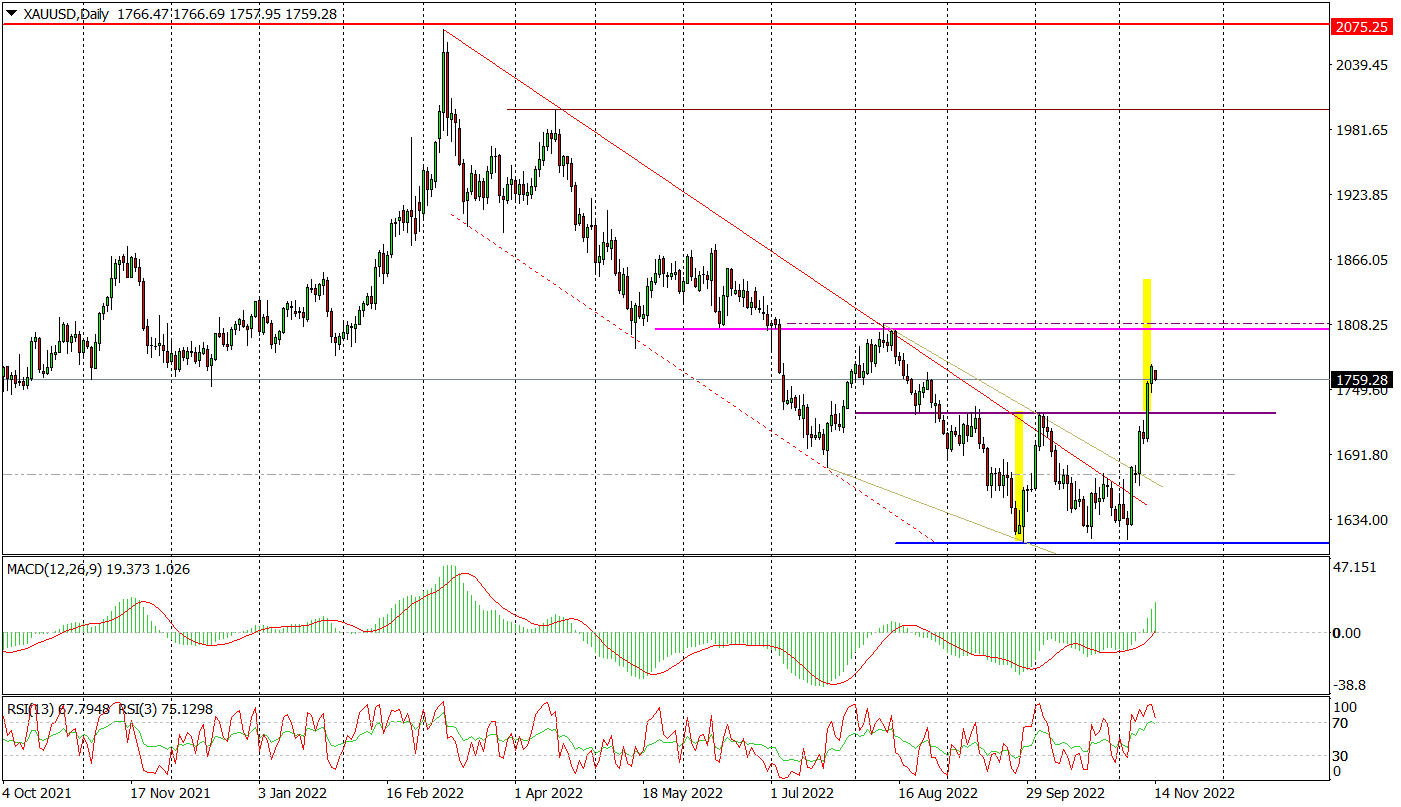Double bottom on gold. We have already broken 9% from the bottom
Is gold gaining at the expense of cryptocurrencies? Who knows. While Cryptocurrency market trembling in its foundations, the gold price looks better and better. Gold has increased by almost 9% since the lows at the beginning of the month. The chart suggests that this rally north is not over yet.
READ: How to buy gold? Everything about investing in gold [Guide]
Gold Analysis - November 14, 2022
At the beginning of November, gold quoted above the low from the end of September, which was the second return from this level in recent weeks. This turn coincided with the improvement in the indicators, where the first demand signals appeared already at the end of the summer holidays.
The real breakthrough, however, took place only on November 10. Data below forecasts inflation in the US triggered a strong jump in gold prices and a break above the local peak at the end of October ($ 1729,48). As a result, a double bottom pattern was formed on the daily chart and strong buy signals generated on the indicators. Adding to this the 8-month bearish line that was broken in the first days of November, gold now has an open road not only to the resistance zone of $ 1800-1807,84, but even to the region of $ 1845. This is the minimum level of increases resulting from the implementation of the above-mentioned double bottom formation.

XAU / USD daily chart (CFDs on gold). Source: Tickmill






















![Forex Club – Tax 9 – Settle tax on a foreign broker [Download the Application] Forex Club - Tax 9](https://forexclub.pl/wp-content/uploads/2024/02/Forex-Club-Podatek-9-184x120.jpg?v=1709046278)
![Trading View platform – solutions tailored to the needs of traders [Review] trading view review](https://forexclub.pl/wp-content/uploads/2024/03/trading-view-recenzja-184x120.jpg?v=1709558918)
![How to connect your FP Markets account to the Trading View platform [Guide] fp markets trading view](https://forexclub.pl/wp-content/uploads/2024/02/fp-markets-trading-view-184x120.jpg?v=1708677291)
![How to invest in ChatGPT and AI? Stocks and ETFs [Guide] how to invest in chatgpt and artificial intelligence](https://forexclub.pl/wp-content/uploads/2023/02/jak-inwestowac-w-chatgpt-i-sztuczna-inteligencje-184x120.jpg?v=1676364263)


![WeWork – the anatomy of the collapse of a company valued at $47 billion [WeWork, part II] wework bankruptcy story](https://forexclub.pl/wp-content/uploads/2024/04/wework-bankructwo-historia-184x120.jpg?v=1711729561)
![Adam Neumann – the man who screwed up Softbank [WeWork, part AND] adam neumann wework](https://forexclub.pl/wp-content/uploads/2024/04/adam-neumann-wework-184x120.jpg?v=1711728724)





![How to transfer shares to another brokerage office [Procedure description] how to transfer shares to another brokerage house](https://forexclub.pl/wp-content/uploads/2024/03/jak-przeniesc-akcje-do-innego-biura-maklerskiego-184x120.jpg?v=1709556924)

![The most common mistakes of a beginner trader - Mr Yogi [VIDEO] Scalping - The most common mistakes of a beginner trader - VIDEO](https://forexclub.pl/wp-content/uploads/2024/03/Scalping-Najczestsze-bledy-poczatkujacego-tradera-VIDEO-184x120.jpg?v=1711601376)
![Learning patience: No position is also a position - Mr Yogi [VIDEO] Scalping - Learning patience - No position is also a position - VIDEO](https://forexclub.pl/wp-content/uploads/2024/03/Scalping-Nauka-cierpliwosci-Brak-pozycji-to-tez-pozycja-VIDEO-184x120.jpg?v=1710999249)
![When to exit a position and how to minimize losses - Mr Yogi [VIDEO] Scalping - When to exit a position and how to minimize losses - VIDEO](https://forexclub.pl/wp-content/uploads/2024/03/Scalping-Kiedy-wyjsc-z-pozycji-i-jak-minimalizowac-straty-VIDEO-184x120.jpg?v=1710336731)









